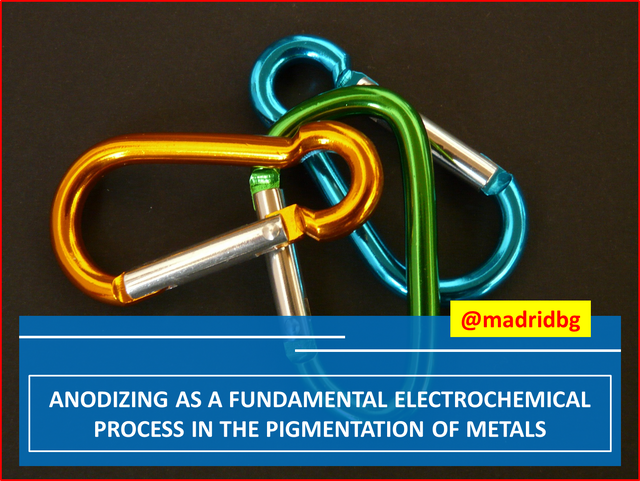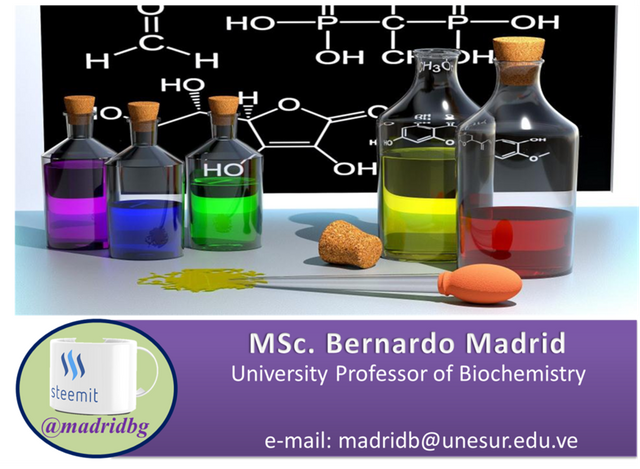ANODIZING AS A FUNDAMENTAL ELECTROCHEMICAL PROCESS IN THE PIGMENTATION OF METALS

Authored by @madridbg, via Power Point 2010, using public domain images. Hans Braxmeier
Greetings and welcome dear readers of this prestigious platform. The following publication is of a scientific nature under a flexible methodology that allows to study the advances and applications of chemistry applied to everyday processes.
In this sense, through the @project.hope community, we will be addressing what concerns the anodizing process as a mechanism that allows the pigmentation of metals used in electrochemical art.
INTRODUCTION

The chemical processes associated with the electrical flow, have had a wide progress from the mobility of the human being, where these principles are applied in the operation of everyday equipment, among which stand out, cars, watches, digital cameras, telephones, among other devices that need energy to function.
Energy that results from the development of sophisticated mechanisms called cells or batteries that allow the transformation of chemical reactions into electrical energy useful for our common use, where electrochemistry as an area of chemistry is responsible for the study and understanding of the transformation or inter-conversion of chemical energy into electrical energy.
Its importance lies in the possibility of implementation at the level of technological and scientific processes, in addition to generating the possibilities of manufacturing and processing of basic or essential industrial materials among which are the obtaining of chlorine, used in the manufacture of plastics, sodium hydroxide, essential in the textile industry, in the manufacture of paper, as well as in the production of soaps and detergents.
However, beyond the multiple uses, we will focus on the approach applied in obtaining metals such as aluminum and copper in pure state, as well as in the process of pigmentation of these, which gives rise to the development of what is now known as electrochemical art.
OVERVIEW OF THE ANODIZING PROCESS

From the chemical point of view, the electrochemical processes that allow the formation and increase of the thickness of the oxide layer of some metals is known as anodizing, this technique is implemented as a mechanism of protection of many metals that we use in our daily lives, such in the case of aluminum, copper and in many cases silver.
The generation of the oxide layer follows electrochemical principles that give metals resistance, durability and beauty, an aspect that we will study in depth in the following section.
According to the type of oxide layer we want to obtain, these can vary from the thinnest ones ranging from 5 to 10 microns thick, to those ranging from 11 to 20 microns of oxide generated on the surface of the metal. Anodizing as a chemical process depends on variables such as the amperage used in the applied electric current, the type of electrolytic, the duration of the treatment, as well as the temperature to which the process is subjected.

Fig. 2. Representation of the anodizing process. Author: User:Polyparadigm
Although the anodizing process has evolved over time and the pieces obtained radiate different colors, the technique follows the same chemical principle, where the electrolytic processes are responsible for the oxide layer generated.
Currently anodizing is combined with techniques based on optical interference, which generates a wide variety of colors in the finish of the material, generating blue, red, green pigmentation, among others.
ANODIZING AS A PRINCIPLE OF ELECTROCHEMICAL ART

As mentioned in the previous section, anodizing is an electrochemical process that allows the formation of a layer of oxides on the surface of certain metals, where according to the pigmentation treatment applied can generate a high contrast finish in the materials where it is used.
An example of this is represented by aluminum materials, where by means of the technique an oxidation is achieved on the surface of the anode provided with the metal that will be modified by the formation of the corresponding oxide where the thickness of the oxide depends on the type of work to which the generated material will be subjected.

Fig. 3. Representation of the redox process of aluminum anodizing. Author: Chang, 2010.
If we analyze the above equation we realize that the anode is formed by the metal under study, in this particular, aluminum which will be subjected to a process of oxidation-reduction, where it will be this who will end up oxidizing along the system.
As mentioned above, the thickness of the generated layer depends on variables such as temperature, current intensity, electrolyte, as well as the porosity of the generated layer, which will be responsible for the coloration obtained.
Chemically, when a dye is added to the electrolyte, the molecules are able to penetrate the newly formed oxide layer of spongy texture, which are trapped when the surface hardens on the metal and gives the characteristic color to the materials.

Fig. 4. Pigmentation is according to the absorption of the pigment on the porous surface of the oxide layer formed. Author: analogicus
FINAL CONSIDERATIONS

From the chemical point of view, anodizing is a topic of relevant use at present, attributable to the characteristics and finishes that it confers to metals, in the same way the electrochemical processes have allowed the development of technological and scientific processes that allow us to enjoy equipment of daily interest and from the comfort of our hands, referring to laptops and cellular equipment.
Which shows that correct uses of chemical knowledge translate into substantial advances for humanity and its desire for development, so that we must continue to promote a contextualized chemistry teaching, where we are able to observe this science in a simple and not abstract way.
CONSULTED BIBLIOGRAPHICAL REFERENCES


[1] Chang, R. (2010). Química. Decima edición. McGraw-hill Interamericana editores. ISBN: 978-607-15-0307-7.
[2] Ralph, H. Petrucci, William S. Harwood, E. Geoffrey Herring. (2003). QUIMICA GENERAL. Octava edición. PEARSON EDUCACIÓN. S.A., Madrid.
[3] WADE,LEROY. (2011). . QUÍMICA ORGÁNICA. VOLUMEN 2. SÉPTIMA EDICIÓN. PEARSON EDUCACIÓN, MÉXICO, 2011 ISBN: 978-607-32.()793•5. ÁREA: CIENCIAS
OF INTEREST

•

Grateful with the community @project.hope and with all the management team of the same one that they motivate us to continue working in a mutual and balanced growth.


Hello @madridbg
Extraordinary post my friend @madridbg, loaded with science in all its expression, it takes me the basic information on this topic of metal pigmentation. Thanks for this delivery.
Best regards, be well.
Greetings @lupafilotaxia, no doubt chemistry and its fundamentals is impressive thanks to its applicability and its presence in all aspects of our lives, in a way this science has come to improve our evolution on earth. Thanks for stopping by and leaving your comment.